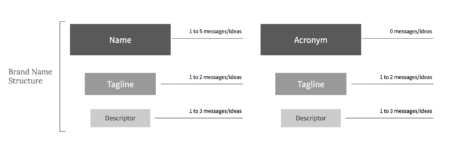Blog Insights
Can an Acronym Name Hurt Your Brand?
Acronyms commonly identify initiatives and processes within an organization, though more commonly than not, an acronym is on the masthead of the organization itself. While acronyms can be an effective and recognizable marketing tool in many cases, in others they may not.
You know that feeling: you just started your position at a new organization, or in a new industry altogether. Now you are faced with weeks of having to ask (either out loud or quietly to yourself), “what does XYZ stand for?” In the nonprofit community specifically, there are a lot of acronyms, many of which are a challenge for the greater public to understand meaningfully. Many nonprofits use acronyms to either make a long organization or program name easier to say or write. More commonly, a long name was organically shortened to an acronym over time by their audiences. Acronyms aren’t meant to communicate any messages unless and only if they are so well-known that audiences can easily translate the acronym to directly to the organization’s core mission.At what point is an acronym name not serving your organization anymore? Or, at what point is it actually hurting your brand?
We help organizations answer these questions when embarking on a significant strategic shift or in need of a rebrand. Here are two questions to consider as you look at your organization’s acronym name:- For a person who has never interacted with your organization before, is it clear what your organization does by looking at your logo and tagline only?
- Presuming your acronym started as or derived from a full name, do you still use the full name in your logo? Or does it at least feature prominently on your communications materials and digital properties?
Two aspects of high-performing brand names
To help frame how you think about your name as part of your brand, here are the biggest aspects we see of an effective brand, especially in the nonprofit sector.1. Your name is your primary communications tool
Imagine your logo on a busy board of logos at an event. There’s no website hero image or lengthy description to help you capture attention and communicate your purpose. At best, you have three elements to help you achieve these goals—your logo icon or shape, your name, and possibly your tagline and a descriptor line. That’s it. The diagram below shows how to best use the elements to communicate the most to your audiences. How does your organization do in effectively communicating what you do to people using only those three visual vehicles?
Let’s remove the visual. Imagine you launched a new initiative or fundraiser and it is getting some buzz. People are talking about it in person and in videos and text on social media. They are saying the name of your organization to other people in their circles. How well are these people positioned to communicate your name consistently and easily? More importantly, is it clear what you do in this short post through your audiences’ voices?
Maybe you are having the revelation that many of our clients have when they consider these scenarios, that these three vehicles—logo visual, name, tagline—need to be considered and crafted with great strategic care.
How does your organization do in effectively communicating what you do to people using only those three visual vehicles?
Let’s remove the visual. Imagine you launched a new initiative or fundraiser and it is getting some buzz. People are talking about it in person and in videos and text on social media. They are saying the name of your organization to other people in their circles. How well are these people positioned to communicate your name consistently and easily? More importantly, is it clear what you do in this short post through your audiences’ voices?
Maybe you are having the revelation that many of our clients have when they consider these scenarios, that these three vehicles—logo visual, name, tagline—need to be considered and crafted with great strategic care.
2. Your name evokes consistent and strong emotion
Acronyms are emotionless, brands are not. Brands evoke emotion. Great brands evoke consistent and strong emotions. Unless your organization is just getting started, your organization’s brand already has some sort of emotional connection with your audiences. Our in-depth experience in brand perception research across many types of organizations shows that it is this emotional connection that truly drives consistent action. With this data in mind, think about your brand experience and how you are creating this emotional connection. Go ahead and fire up your website homepage and start scrolling. What parts of this page elicit an emotional response from an interested person?Is it the hero image? Is it the compelling headline over your main call-to-action area? Is it really hard to find something that elicits an emotional response?
If the goal is to start creating an emotional connection at the first or an earlier touchpoint, it becomes imperative to find ways to infuse emotive elements in these top three brand vehicles — logo graphic, name and/or tagline. This shines a glaring spotlight on the once benign acronym. By their nature, being a series of letters, they cannot evoke emotion. Acronyms are the epitome of function. In this scenario with the goal to capture emotion quickly and often, you are relying on the logo artwork and the tagline to achieve this.Case study: rebranding ATLA to Atla
Forum One recently conducted a comprehensive global rebrand for Atla. With a 73-year history, the acronym ATLA, derived from its former name, the American Theological Library Association, had become a household name among target audience groups, including theological librarians, scholars, and publishers, to name a few. Our brand perception research process identified the need to remove the words “American” and “Theological” from the organization name, as audiences saw this as a barrier to the strategic vision as a global and inclusive organization among many religions.
Including this important data from the audience research, a few other factors led to our strategic guidance to remove the acronym and turn the organization name into a word, Atla:
Our brand perception research process identified the need to remove the words “American” and “Theological” from the organization name, as audiences saw this as a barrier to the strategic vision as a global and inclusive organization among many religions.
Including this important data from the audience research, a few other factors led to our strategic guidance to remove the acronym and turn the organization name into a word, Atla:
- Removing the words “American” and “Theological” from the full organization name was not enough, as the acronym was intrinsically connected to the words in the name.
- The acronym was being said verbally by people as both “A-T-L-A” and “Atla,” with more people using the latter.
- This intentional change as part of the rebrand cued people that this familiar name is now new, being intentionally re-launched as a word and as the new name, Atla.